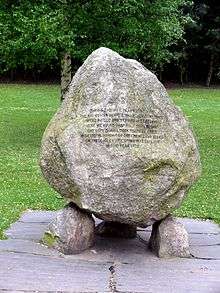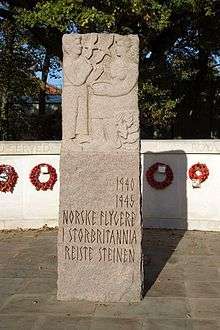Free Norwegian forces

The Norwegian armed forces in exile (Norwegian: Utefronten, "Forces Abroad") were remnants of the armed forces of Norway that continued to fight the Axis powers from Allied countries, such as Britain and Canada, after they had escaped the German conquest of Norway during World War II.
Background
Norway was neutral in World War I and tried to remain neutral in World War II. Neutrality was maintained until April 1940.
There were many moves to purchase equipment in the run up to World War II, including several orders for British, German and American aircraft.
Occupation of Norway

The Royal Norwegian Navy (RNoN) entered the war when Norway was attacked on 9 April 1940. Norwegian coastal artillery sufficiently delayed the German capture of Oslo to permit the King of Norway, the Royal family and the government to flee the capital, and eventually make their way to the United Kingdom.[1] The Norwegian Army was forced northwards from the capital towards Lillehammer where they were joined by two British brigades. It was decided that the Allies should concentrate on the recapture of Narvik, which was entered by the Norwegian 6th Division on 28 May. However, the Allied garrison of the port was unsustainable and it had been evacuated to the United Kingdom by 7 June 1940. Thirteen ships, five aircraft and 500 men from the Royal Norwegian Navy followed. On 10 June, General Otto Ruge signed the treaty of capitulation for the Norwegian Army.[2] The Germans occupied Norway until the German capitulation on 8 May 1945.
Exiled forces

Army
Unlike the navy and air forces the army was not able to easily escape, and almost all remained in Norway after the German invasion. Some of these men would form part of the Norwegian resistance forces during the rest of the war until Norway regained freedom in May 1945.
Norwegian soldiers in the United Kingdom formed units including the Norwegian Independent Company 1, and 5 Troop of the No. 10 (Inter-Allied) Commando. During the years in exile in Britain the bulk of the Norwegian Army consisted of a brigade in Dumfries,[3] and smaller units stationed in Iceland, Jan Mayen, Svalbard and South Georgia. Some units were sent to take part in the liberation of Finnmark.

Navy
The forces that had escaped to the United Kingdom were slowly built up over the next few years. On D-Day (6 June 1944), the Royal Norwegian Navy attached to the invasion of Normandy numbered ten ships and 1,000 sailors.
During the war the RNoN operated 118 ships; by the end of the war it had 58 ships and 7,500 men in service.[4]

Air Force
Norway retained separate air forces for the navy and the army until the establishment of the Royal Norwegian Air Force in 1944.
Some aircraft that were ordered prior to hostilities were delivered but few were ready for combat. After the flight to the United Kingdom a training base was established in Canada and many of the pilots joined the RAF in both bomber and fighter commands. Most notable are the two Spitfire squadrons, 331 and 332.[5][6]
On 1 November 1944 these squadrons were incorporated into the new Royal Norwegian Air Force and were renamed as such along with new squadrons: 330 (Northrop N-3PB, Catalina, Sunderlands), 333 (Catalina, Mosquito) and later 334 (Mosquitos).[7][8][9]

Police Troops in Sweden
Norwegian police troops, known as Rikspoliti, were recruited from refugees in Sweden during the war. They were funded by the Norwegian government in exile, and trained by the Swedish military.[10] Originally intended to help maintain order in a post-war Norway, 1,442 were flown in early to assist in the Liberation of Finnmark.[11]
See also
References
- ↑ World War II. (2009). In Encyclopædia Britannica. Retrieved November 18, 2009, from Encyclopædia Britannica Online: http://www.britannica.com/EBchecked/topic/648813/World-War-II
- ↑ THE SECOND WORLD WAR EXPERIENCE CENTRE - The 1940 Norway Campaign
- ↑ Giancarlo Rinaldi (4 November 2010). "Dumfries remembers role as home to Norwegian army". BBC Scotland. Retrieved 28 April 2013.
- ↑ Berg, Ole F. (1997). I skjærgården og på havet – Marinens krig 8. april 1940 – 8. mai 1945 (in Norwegian). Oslo: Marinens krigsveteranforening. p. 154. ISBN 82-993545-2-8.
- ↑ "331 Squadron". raf.mod.uk. 2010.
- ↑ "332 Squadron". raf.mod.uk. 2010.
- ↑ "330 Squadron". raf.mod.uk. 2010.
- ↑ "333 Squadron". raf.mod.uk. 2010.
- ↑ "334 Squadron". raf.mod.uk. 2010.
- ↑ Söderman 1946 pp.9-18
- ↑ Simon Orchard, "THE EVACUATION OF FINNMARK & THE RE-ENTRY OF NORWEGIAN FORCES INTO NORWAY, OCT 1944-MAY 1945."